卷积神经网络狗猫数据集的分类
卷积神经网络狗猫数据集的分类
环境搭建
安装Anaconda
具体安装过程,请自行百度
配置TensorFlow、Keras
- 创建虚拟环境
输入下面命令:
conda create -n ppqppl_tfl python=3.6
#tf1是自己为创建虚拟环境取的名字,后面python的版本可以根据自己需求进行选择
- 激活环境
使用下面命令:
activate
conda activate ppqppl_tfl

- 安装tensorflow和keras
使用下面命令:
pip install 包名
#直接这样安装可以由于网络的原因,安装失败或者安装很慢
#解决方式:
pip install -i https://pypi.tuna.tsinghua.edu.cn/simple 包名
#此次安装命令如下:
pip install -i https://pypi.tuna.tsinghua.edu.cn/simple tensorflow==1.14.0
pip install -i https://pypi.tuna.tsinghua.edu.cn/simple keras==2.2.5
# 安装 nb_conda_kernels 包
conda install nb_conda_kernels
# 如果上述命令报错,请更换下载源
# 经检测,这里清华源下载最快,注意,这里不能使用梯子
安装完成后,我们需要在指定虚拟环境中新建一个 jupyter notebook 项目,执行如下命令即可将指定环境添加到 jupyter notebook 中:
# 第一步,切换到想要添加的虚拟环境:
conda activate data
# 第二步,安装ipykernel包
conda install ipykernel
# 第三部,执行如下命令,并确定环境的名称(此处设置为data)
python -m ipykernel install --name data
然后我们启动 jupyter notebook,创建一个指定环境下的文件即可
这样我们的环境配置就已经成功了
猫狗数据分类建模
猫狗图片数据集下载:https://pan.baidu.com/s/1f-MvZl7_J6DF7P9CGBY3SQ ——提取码:ruyn
数据集下载完毕后,解压缩,并放在一个没有中文路径下,如下图所示:

猫狗图像预处理
对猫狗图像进行分类,代码如下:
import os, shutil
# 原始目录所在的路径
original_dataset_dir = 'D:\\code-file\\conda\\kaggle_Dog&Cat\\train\\'
# 数据集分类后的目录
base_dir = 'D:\\code-file\\conda\\kaggle_Dog&Cat\\train1'
os.mkdir(base_dir)
# # 训练、验证、测试数据集的目录
train_dir = os.path.join(base_dir, 'train')
os.mkdir(train_dir)
validation_dir = os.path.join(base_dir, 'validation')
os.mkdir(validation_dir)
test_dir = os.path.join(base_dir, 'test')
os.mkdir(test_dir)
# 猫训练图片所在目录
train_cats_dir = os.path.join(train_dir, 'cats')
os.mkdir(train_cats_dir)
# 狗训练图片所在目录
train_dogs_dir = os.path.join(train_dir, 'dogs')
os.mkdir(train_dogs_dir)
# 猫验证图片所在目录
validation_cats_dir = os.path.join(validation_dir, 'cats')
os.mkdir(validation_cats_dir)
# 狗验证数据集所在目录
validation_dogs_dir = os.path.join(validation_dir, 'dogs')
os.mkdir(validation_dogs_dir)
# 猫测试数据集所在目录
test_cats_dir = os.path.join(test_dir, 'cats')
os.mkdir(test_cats_dir)
# 狗测试数据集所在目录
test_dogs_dir = os.path.join(test_dir, 'dogs')
os.mkdir(test_dogs_dir)
# 将前1000张猫图像复制到train_cats_dir
fnames = ['cat.{}.jpg'.format(i) for i in range(1000)]
for fname in fnames:
src = os.path.join(original_dataset_dir, fname)
dst = os.path.join(train_cats_dir, fname)
shutil.copyfile(src, dst)
# 将下500张猫图像复制到validation_cats_dir
fnames = ['cat.{}.jpg'.format(i) for i in range(1000, 1500)]
for fname in fnames:
src = os.path.join(original_dataset_dir, fname)
dst = os.path.join(validation_cats_dir, fname)
shutil.copyfile(src, dst)
# 将下500张猫图像复制到test_cats_dir
fnames = ['cat.{}.jpg'.format(i) for i in range(1500, 2000)]
for fname in fnames:
src = os.path.join(original_dataset_dir, fname)
dst = os.path.join(test_cats_dir, fname)
shutil.copyfile(src, dst)
# 将前1000张狗图像复制到train_dogs_dir
fnames = ['dog.{}.jpg'.format(i) for i in range(1000)]
for fname in fnames:
src = os.path.join(original_dataset_dir, fname)
dst = os.path.join(train_dogs_dir, fname)
shutil.copyfile(src, dst)
# 将下500张狗图像复制到validation_dogs_dir
fnames = ['dog.{}.jpg'.format(i) for i in range(1000, 1500)]
for fname in fnames:
src = os.path.join(original_dataset_dir, fname)
dst = os.path.join(validation_dogs_dir, fname)
shutil.copyfile(src, dst)
# 将下500张狗图像复制到test_dogs_dir
fnames = ['dog.{}.jpg'.format(i) for i in range(1500, 2000)]
for fname in fnames:
src = os.path.join(original_dataset_dir, fname)
dst = os.path.join(test_dogs_dir, fname)
shutil.copyfile(src, dst)
分类后如下图所示:


查看分类后,对应目录下的图片数量:
#输出数据集对应目录下图片数量
print('total training cat images:', len(os.listdir(train_cats_dir)))
print('total training dog images:', len(os.listdir(train_dogs_dir)))
print('total validation cat images:', len(os.listdir(validation_cats_dir)))
print('total validation dog images:', len(os.listdir(validation_dogs_dir)))
print('total test cat images:', len(os.listdir(test_cats_dir)))
print('total test dog images:', len(os.listdir(test_dogs_dir)))

猫狗训练图片各 1000 张,验证图片各 500 张,测试图片各 500 张
猫狗分类的实例——基准模型
构建网络模型:
#网络模型构建
from keras import layers
from keras import models
#keras的序贯模型
model = models.Sequential()
#卷积层,卷积核是3*3,激活函数relu
model.add(layers.Conv2D(32, (3, 3), activation='relu',
input_shape=(150, 150, 3)))
#最大池化层
model.add(layers.MaxPooling2D((2, 2)))
#卷积层,卷积核2*2,激活函数relu
model.add(layers.Conv2D(64, (3, 3), activation='relu'))
#最大池化层
model.add(layers.MaxPooling2D((2, 2)))
#卷积层,卷积核是3*3,激活函数relu
model.add(layers.Conv2D(128, (3, 3), activation='relu'))
#最大池化层
model.add(layers.MaxPooling2D((2, 2)))
#卷积层,卷积核是3*3,激活函数relu
model.add(layers.Conv2D(128, (3, 3), activation='relu'))
#最大池化层
model.add(layers.MaxPooling2D((2, 2)))
#flatten层,用于将多维的输入一维化,用于卷积层和全连接层的过渡
model.add(layers.Flatten())
#全连接,激活函数relu
model.add(layers.Dense(512, activation='relu'))
#全连接,激活函数sigmoid
model.add(layers.Dense(1, activation='sigmoid'))
运行后出现以下错误:

这是由于 numpy 版本与 tensorflow 版本不匹配的问题,安装 1.16.4 版本的 numpy 即可,命令如下:
pip install numpy==1.16.4 -i "https://pypi.doubanio.com/simple/"
重新再运行程序,就没有错误了,但是有警告(因为版本比较老了),没事
查看模型各层的参数状况:
#输出模型各层的参数状况
model.summary()
结果如下图所示:
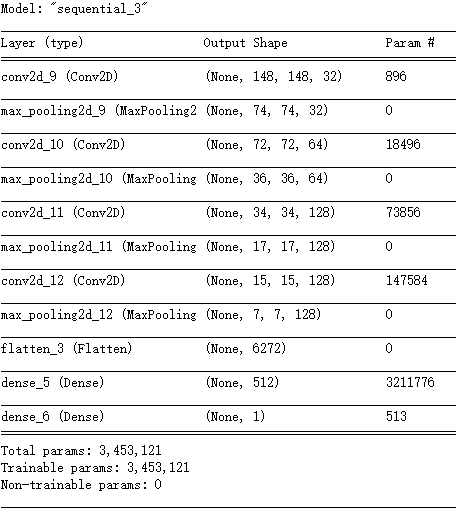
配置优化器:
loss:计算损失,这里用的是交叉熵损失
metrics:列表,包含评估模型在训练和测试时的性能的指标
from keras import optimizers
model.compile(loss='binary_crossentropy',
optimizer=optimizers.RMSprop(lr=1e-4),
metrics=['acc'])
图片格式转化
所有图片(2000张)重设尺寸大小为 150x150 大小,并使用 ImageDataGenerator 工具将本地图片 .jpg 格式转化成 RGB 像素网格,再转化成浮点张量上传到网络上
from keras.preprocessing.image import ImageDataGenerator
# 所有图像将按1/255重新缩放
train_datagen = ImageDataGenerator(rescale=1./255)
test_datagen = ImageDataGenerator(rescale=1./255)
train_generator = train_datagen.flow_from_directory(
# 这是目标目录
train_dir,
# 所有图像将调整为150x150
target_size=(150, 150),
batch_size=20,
# 因为我们使用二元交叉熵损失,我们需要二元标签
class_mode='binary')
validation_generator = test_datagen.flow_from_directory(
validation_dir,
target_size=(150, 150),
batch_size=20,
class_mode='binary')
输出结果:

查看上述图像预处理过程中生成器的输出
#查看上面对于图片预处理的处理结果
for data_batch, labels_batch in train_generator:
print('data batch shape:', data_batch.shape)
print('labels batch shape:', labels_batch.shape)
break
如果出现错误:ImportError: Could not import PIL.Image. The use of load_img requires PIL,是因为没有安装 pillow 库导致的,使用如下命令在 ppqppl_tfl 虚拟环境中安装:
pip install pillow -i https://pypi.tuna.tsinghua.edu.cn/simple
安装完毕后,关闭 Jupyter Notebook 重新打开,重新运行一遍程序即可
输出结果如下:

开始训练模型(此时,我的电脑在飞速运转…)
#模型训练过程
history = model.fit_generator(
train_generator,
steps_per_epoch=100,
epochs=30,
validation_data=validation_generator,
validation_steps=50)
电脑性能越好,它训练得越快
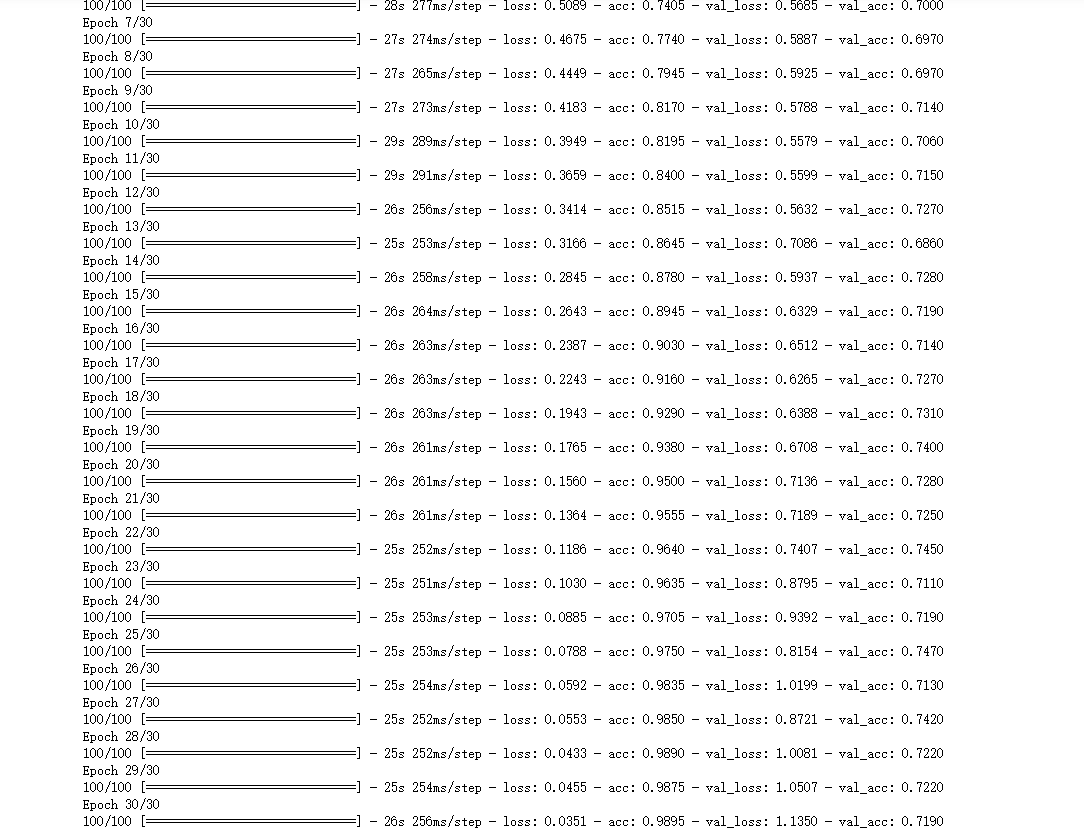
保存模型
#保存训练得到的的模型
model.save('G:\\Cat_And_Dog\\kaggle\\cats_and_dogs_small_1.h5')
结果可视化
#对于模型进行评估,查看预测的准确性
import matplotlib.pyplot as plt
acc = history.history['acc']
val_acc = history.history['val_acc']
loss = history.history['loss']
val_loss = history.history['val_loss']
epochs = range(len(acc))
plt.plot(epochs, acc, 'bo', label='Training acc')
plt.plot(epochs, val_acc, 'b', label='Validation acc')
plt.title('Training and validation accuracy')
plt.legend()
plt.figure()
plt.plot(epochs, loss, 'bo', label='Training loss')
plt.plot(epochs, val_loss, 'b', label='Validation loss')
plt.title('Training and validation loss')
plt.legend()
plt.show()
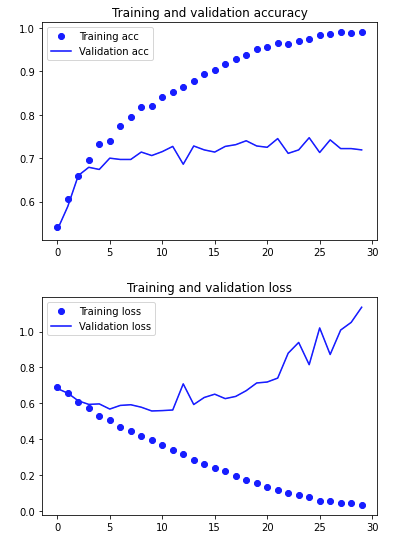
训练结果如上图所示,很明显模型上来就过拟合了,主要原因是数据不够,或者说相对于数据量,模型过复杂(训练损失在第 30 个 epoch 就降为 0 了),训练精度随着时间线性增长,直到接近 100%,而我们的验证精度停留在 70-72%。我们的验证损失在 5 个 epoch 后达到最小,然后停止,而训练损失继续线性下降,直到接近 0
数据增强
什么是数据增强?
数据集增强主要是为了减少网络的过拟合现象,通过对训练图片进行变换可以得到泛化能力更强的网络,更好的适应应用场景。
常用的数据增强方法有:
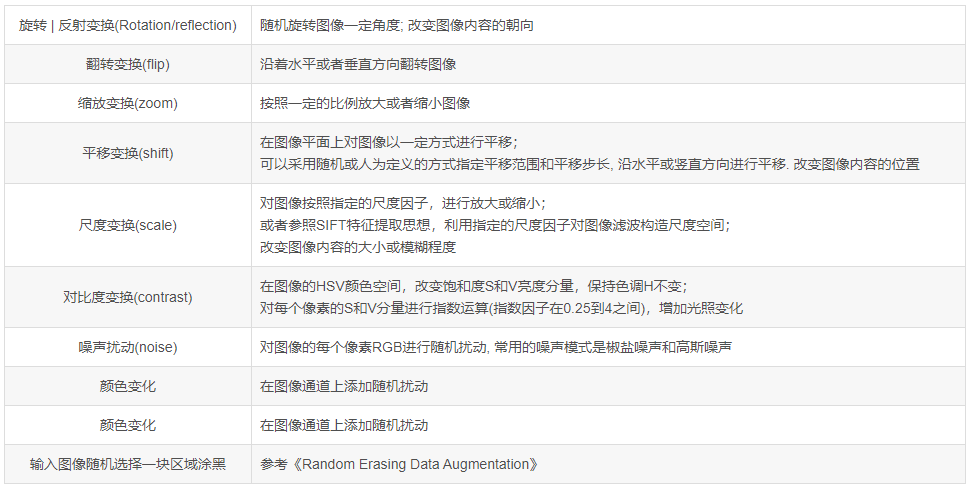
重新构建模型:
上面建完的模型就保留着,我们重新建一个 .ipynb 文件,重新开始建模。
首先猫狗图像预处理,只不过这里将分类好的数据集放在 train2 文件夹中,其它的都一样
然后配置网络模型、构建优化器,然后进行数据增强,代码如下:
图像数据生成器增强数据:
from keras.preprocessing.image import ImageDataGenerator
datagen = ImageDataGenerator(
rotation_range=40,
width_shift_range=0.2,
height_shift_range=0.2,
shear_range=0.2,
zoom_range=0.2,
horizontal_flip=True,
fill_mode='nearest')
参数解释:

查看数据增强后的效果:
import matplotlib.pyplot as plt
# This is module with image preprocessing utilities
from keras.preprocessing import image
fnames = [os.path.join(train_cats_dir, fname) for fname in os.listdir(train_cats_dir)]
# We pick one image to "augment"
img_path = fnames[3]
# Read the image and resize it
img = image.load_img(img_path, target_size=(150, 150))
# Convert it to a Numpy array with shape (150, 150, 3)
x = image.img_to_array(img)
# Reshape it to (1, 150, 150, 3)
x = x.reshape((1,) + x.shape)
# The .flow() command below generates batches of randomly transformed images.
# It will loop indefinitely, so we need to `break` the loop at some point!
i = 0
for batch in datagen.flow(x, batch_size=1):
plt.figure(i)
imgplot = plt.imshow(image.array_to_img(batch[0]))
i += 1
if i % 4 == 0:
break
plt.show()

图片格式转化
train_datagen = ImageDataGenerator(
rescale=1./255,
rotation_range=40,
width_shift_range=0.2,
height_shift_range=0.2,
shear_range=0.2,
zoom_range=0.2,
horizontal_flip=True,)
# Note that the validation data should not be augmented!
test_datagen = ImageDataGenerator(rescale=1./255)
train_generator = train_datagen.flow_from_directory(
# This is the target directory
train_dir,
# All images will be resized to 150x150
target_size=(150, 150),
batch_size=32,
# Since we use binary_crossentropy loss, we need binary labels
class_mode='binary')
validation_generator = test_datagen.flow_from_directory(
validation_dir,
target_size=(150, 150),
batch_size=32,
class_mode='binary')

开始训练并保存结果
history = model.fit_generator(
train_generator,
steps_per_epoch=100,
epochs=100,
validation_data=validation_generator,
validation_steps=50)
model.save('E:\\Cat_And_Dog\\kaggle\\cats_and_dogs_small_2.h5')
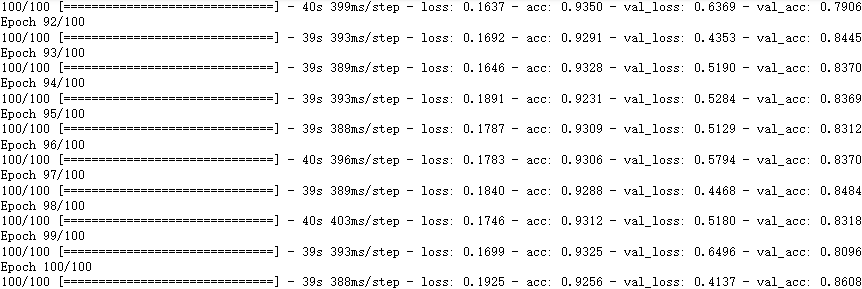
结果可视化:
acc = history.history['acc']
val_acc = history.history['val_acc']
loss = history.history['loss']
val_loss = history.history['val_loss']
epochs = range(len(acc))
plt.plot(epochs, acc, 'bo', label='Training acc')
plt.plot(epochs, val_acc, 'b', label='Validation acc')
plt.title('Training and validation accuracy')
plt.legend()
plt.figure()
plt.plot(epochs, loss, 'bo', label='Training loss')
plt.plot(epochs, val_loss, 'b', label='Validation loss')
plt.title('Training and validation loss')
plt.legend()
plt.show()
如下图所示:
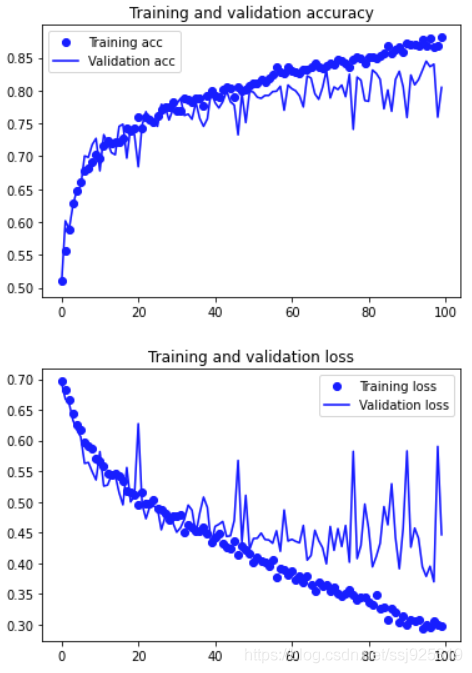
由于数据量的增加,对比基准模型,可以很明显的观察到曲线没有过度拟合了,训练曲线紧密地跟踪验证曲线,这也就是数据增强带来的影响,但是可以发现它的波动幅度还是比较大的
下面在此数据增强的基础上,再增加一层 dropout 层,再来训练看看
dropout 层
什么是dropout层?
Dropout层在神经网络层当中是用来干嘛的呢?它是一种可以用于减少神经网络过拟合的结构,那么它具体是怎么实现的呢?
假设下图是我们用来训练的原始神经网络:
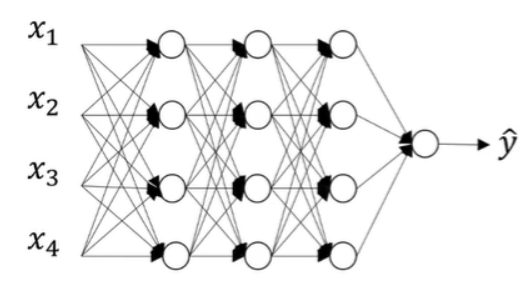
一共有四个输入 \(x_i\),一个输出 y 。Dropout 则是在每一个 batch 的训练当中随机减掉一些神经元,而作为编程者,我们可以设定每一层 dropout(将神经元去除的的多少)的概率,在设定之后,就可以得到第一个 batch 进行训练的结果:
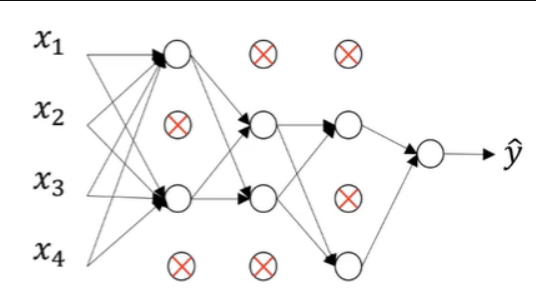
从上图我们可以看到一些神经元之间断开了连接,因此它们被 dropout 了!dropout顾名思义就是被拿掉的意思,正因为我们在神经网络当中拿掉了一些神经元,所以才叫做 dropout 层
具体实现:
在数据增强的基础上,再添加一个 dropout 层
#退出层
model.add(layers.Dropout(0.5))
如下图所示,仅在构建网络模型时添加一层即可,其余部分不变:
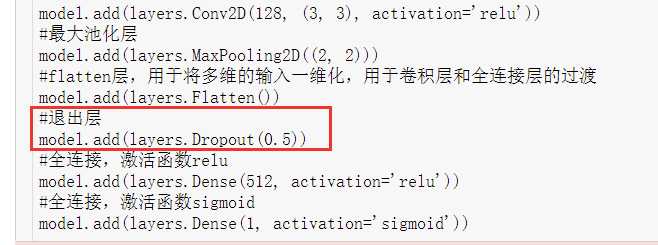
再次训练模型,查看训练结果如下:
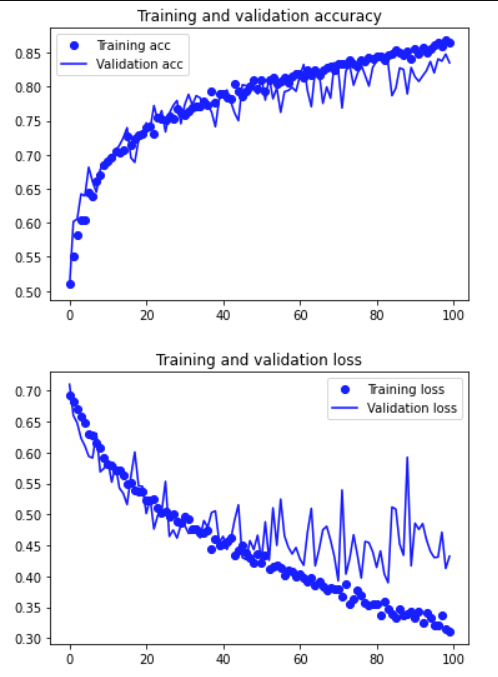
相比于只使用数据增强的效果来看,额外添加一层 dropout 层,仔细对比,可以发现训练曲线更加紧密地跟踪验证曲线,波动的幅度也降低了些,训练效果更棒了

